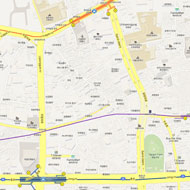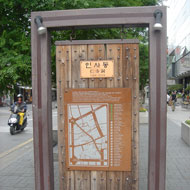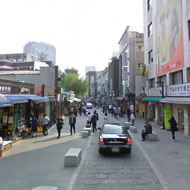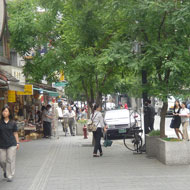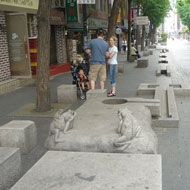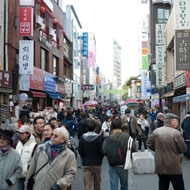Insadong-gil is a great example of a shared road that respects its historic past while meeting the changing needs of modern street users. It is a narrow road in Insadong, a historic neighborhood in Jongno-gu District of Seoul in South Korea. The district is bordered by Gwanhundong to the north, Nagwon-dong to the east, and Jongno 2-ga and Jeokseon-dong to the south, and Gongpyeong-dong to the west. The street is only approximately 0.4 miles long and 33 feet to 49 feet wide. Along the street, there are a multitude of antique shops, traditional paper shops, galleries, cafes and restaurants. The three lines of Seoul Metro (subway) and free shuttle buses connect the area to other destinations.
The Insadong has a long history. It was originally two towns whose names ended in the syllables "In" and "Sa." They were divided by a stream which ran along Insadong's current main street. It began 500 years ago as an area of residence for government officials. During the Japanese occupation, the wealthy Korean residents were forced to move and sell their belongings. The site became an area for trading in antiques. It was a popular destination among foreign visitors to South Korea during the 1960s, who called the area Mary's Alley. In 1988, it became a historic and cultural street. To keep the traditional Korean feel of Insadong intact, the city allows only certain types of businesses in the area. Most of these older buildings are now used as restaurants or shops. Among the historically significant buildings located in the area are Unhyeongung mansion, Jogyesa, one of the most significant Korean Buddhist temples, and one of Korea’s oldest Presbyterian churches.
From 1999 to 2000, the City redesigned the street as an unique corridor for experiencing history and culture. For the street section north of of Insadong 5-gil, the asphalt pavement was replaced by traditional Korean black tiles. The flush 'curbless' road was maintained by replacing ugly cement roadblocks with elegant granite slabs, thereby demarcating a clear path of travel for automobile. The granite paving for the automobile way is rougher and stands in the contrast with the more polished texture that is primarily used by pedestrians, temporary parking and for loading and unloading services. New trees with planters and additional seating help create comfortable areas for sitting and gathering.
The section south of Insadong 5-gil continues most of the pedestrian friendly features including trees in planters, granite slabs for seating and Korean black tiles for sidewalk paving. However, the automobile way has asphalt surface and separated from the formal sidewalk by a small curb. Most of the street is a one way street open to automobile traffic. The entire street is closed to traffic on Sundays. The two ends of the street are defined by venues for social gathering and performances as well as information centers for tourists. Overall, the street was redesigned to allow for more festivals such as the six day annual Insa festival, that would attract both locals and tourists. To further beautify the neighborhood, old and unsightly utility poles were removed with floral containers. The widened sidewalks, traditional pavement and the narrower vehicle road have made the Insadong-gil more pedestrian-friendly.One of the key elements that imbues the street with a unique identity is the custom designed signage and seating. The street furnishings celebrate the mix of of historical and modern architecture that can be seen along the street. Wide variety of seating fixtures exist. Engravings in the seating tell stories of the its past historic past. Art is also integrated in the design of gateways, seating, planters and fountains.
Insadong is the place where 40 percent of the nation’s antique shops and galleries as well as 90 percent of the traditional stationary shops are located. This place is also famous for traditional tea and Korean food, which enhance the sensory experience of the locals and tourists. A multitude of street performances by artists makes the street experience memorable. There are daily calligraphy demonstrations and pansori performances of traditional Korean music. This formal and informal programming of street life helps strengthen its ability to remain an identifiable street.
Adopted from: Insadong
Lessons Learned
Potential Benefits:
- Creates a pedestrian-friendly environment with the widened sidewalk, narrowed road, lined trees and public seats, providing a pleasant walking experience.
- Enlarges the pedestrian realm by closing the street to traffic every Sunday.
- Creates a unique streetscape that provides a sensory experience as well as historic experience of Korea with artistic street performances, galleries, and the antique shops in the historic buildings.
Potential Issues:
- Restriction on the type of businesses: Even though the city restricts the sprawling of Western chains, the street has become more tourist-oriented, losing its personality because of an excessive number of souvenir shops and other tourist-oriented businesses.
- Pedestrian traffic: Since the Insadong-gil is one of the most popular streets in Seoul, especially on the weekend, it is difficult to maneuver one’s way through the crowd. Some people may enjoy being in the crowd, but some may find it unpleasant.
- Shared streets: During the weekdays, the through traffic and illegally parked cars makes the narrow road even busier, disrupting pedestrian flow.
Sources
Korea Tourism Organization (http://english.visitkorea.or.kr/enu/SI/SI_EN_3_1_2_4.jsp?gotoPage=&category=&areaCode=&folderId=19917&recommCid=863947&cidList=&cid=264354&out_service=)
Photo Sources
MIG, Inc.

